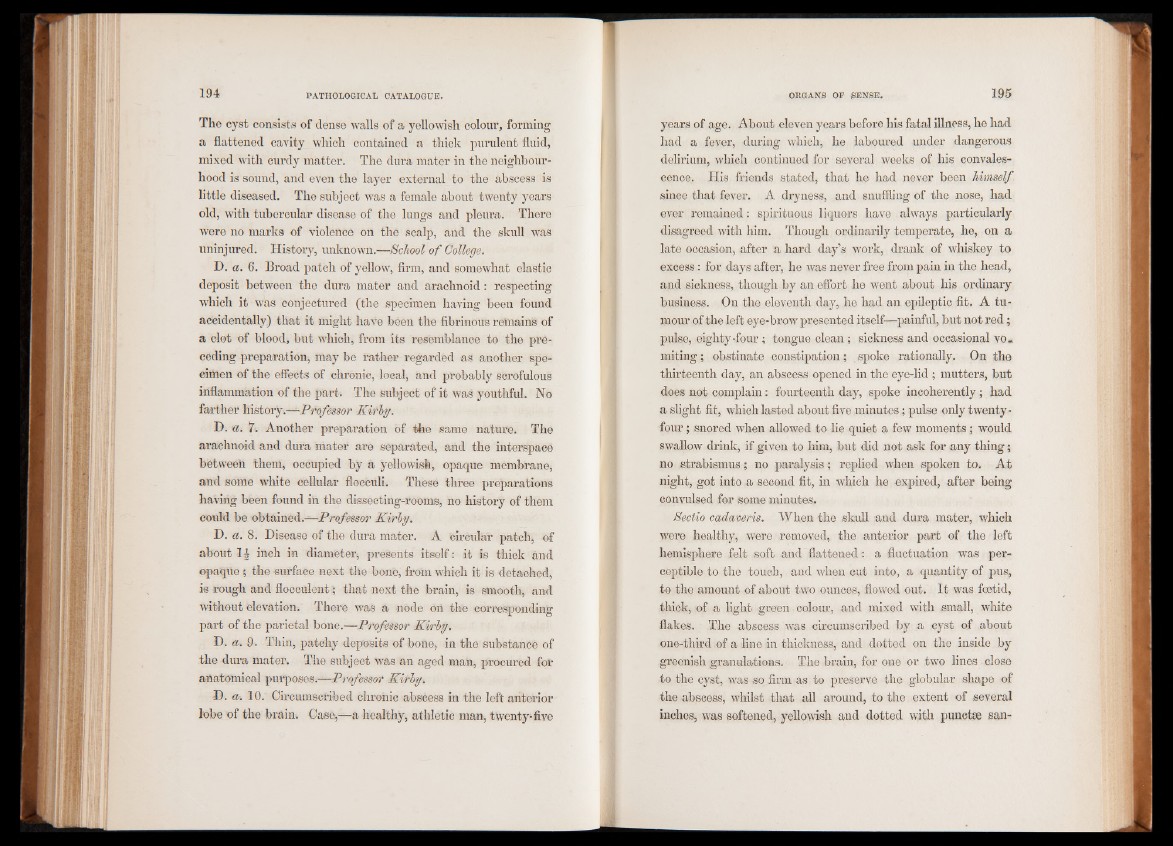
The cyst consists of dense walls of a yellowish colour, forming
a flattened cavity which contained a thick purulent fluid,
mixed with curdy matter. The dura mater in the neighbourhood
is sound, and even the layer external to the abscess is
little diseased. The subject was a female about twenty years
old, with tubercular disease of the lungs and pleura. There
were no marks of violence on the scalp, and the skull was
uninjured. History, unknown.—School of College.
D. a. 6. Broad patch of yellow, firm, and somewhat elastic
deposit between the dura mater and arachnoid: respecting
which it was conjectured (the specimen having been found
accidentally) that it might have been the fibrinous remains of
a clot of blood, but which, from its resemblance to the preceding
preparation, may be rather regarded as another specimen
of the effects of chronic, local, and probably scrofulous
inflammation of the part. The subject of it was youthful. No
farther history.—Professor Kirby.
D. u. 7. Another preparation of the same nature. The
arachnoid and dura mater are separated, and the interspace
between them, occupied by a yellowish, opaque membrane,
and some white cellular floeculi. These three preparations
having been found in the dissecting-rooms, no history of them
could be obtained.—Professor Kirby.
D. a. 8. Disease of the dura mater. A circular patch, of
about inch in diameter* presents itself: it is thick and
opaque $ the surface next the bone, from which it is detached,
is rough and floceulent; that next the brain, is smooth, and
without elevation. There was a node on the corresponding
part of the parietal bone.—Professor Ki/rby%
D. a. 9. Thin, patchy deposits of bone, in the substance of
the dura mater. The subject Was an aged man, procured for
anatomical purposes.—Professor Kirby.
D. a. 10 . Circumscribed chronic abscess in the left anterior
lobe of the brain. Case,—a healthy, athletic man, twenty-five
years of age. About eleven years before his fatal illness, he had
had a fever, during which, he laboured under dangerous
delirium, which continued for several weeks of his convalescence.
His friends stated, that he had never been himself
since that fever. A dryness, and snuffling of the nose, had
ever remained: spirituous liquors have always particularly
disagreed with him. Though ordinarily temperate, he, on a
late occasion, after a hard day’s work, drank of whiskey to
excess: for days after, he was never free from pain in the head,
and sickness, though by an effort he went about his ordinary
business. On the eleventh day, he had an epileptic fit. A tumour
of the left eye-brow presented itself—painful, but not red;
pulse, eighty-four ; tongue clean; sickness and occasional vomiting
; obstinate constipation; spoke rationally. On the
thirteenth day, an abscess opened in the eye-lid ; mutters, but
does not complain: fourteenth day, spoke incoherently ; had
a slight fit, which lasted about five minutes; pulse only twenty-
four; snored when allowed to lie quiet a few moments; would
swallow drink, if given to him, but did not ask for any thing;
no strabismus; no paralysis; replied when spoken to. At
night, got into a second fit, in which he expired, after being
convulsed for some minutes.
Sectio cadaver is. When the skull and dura mater, which
were healthy, were removed, the anterior part of the left
hemisphere felt soft and flattened : a fluctuation was perceptible
to the touch, and when cut into, a quantity of pus,
to the amount of about two ounces, flowed out. It was foetid,
thick, of a light green colour, and mixed with small, white
flakes. The abscess was circumscribed by a cyst of about
one-third of a line in thickness, and dotted on the inside by
greenish granulations. The brain, for one or two lines close
to the cyst, was so firm as to preserve the globular shape of
the abscess, whilst that all around, to the extent of several
inches, was softened, yellowish and dotted with punctse san